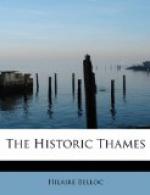It was in the thirteenth century also that a bridge was thrown across the river at this point—that is, Henley possessed a bridge long before Wallingford, and at a time when the river could be crossed by road in but very few places. The granting of a number of indulgences, and the promises of masses in the middle of the thirteenth century for this object, give us the date; and, what is perhaps equally interesting, this early bridge was of stone.
It is usual to think of the early bridges over the Thames as wooden bridges. Aft older generation was accustomed to many that still remained. This was true of the later Middle Ages, and of the torpor and neglect in building which followed the Reformation. But it was not true of the thirteenth and fourteenth centuries. The bridge at Henley, like the bridge of Wallingford and the later bridge of Abingdon, was of stone.
It was allowed to fall into decay, and when Leland crossed the river at this point it was upon a wooden bridge, the piers of which stood upon the old foundation. How long that wooden bridge had existed in 1533, when Leland noticed it, we cannot tell, but it remained of wood until 1786, when the present bridge replaced it.
In spite of the early importance of the town, it was not regularly incorporated for a long time, but was governed by a Warden, the first on the list being the date of 1305, within the reign of Edward I. The charter which gave Henley a Mayor and Corporation was granted as late as the reign of Henry VIII. and but a few years before Leland’s visit. From that moment, however, the town ceased to expand, either in importance or in numbers; the destruction of Reading Abbey and of the Cell of Westminster at Hurley just over the river, very possibly affected its prosperity. At the beginning of the nineteenth century it had a population of less than 3000, and sixty years later it had not added another 1000 to that number.
Maidenhead follows, for centuries, a sort of parallel course to the development of Henley.
Recently, of course, it has very largely increased in population, and in this it is an example in a minor degree of what Reading and Oxford are in a major degree—that is, of the changes which the railway has made in the Thames Valley. But until the effect of the railway began to be felt Maidenhead was the younger and parallel town to Henley.




